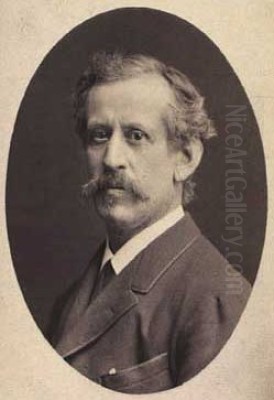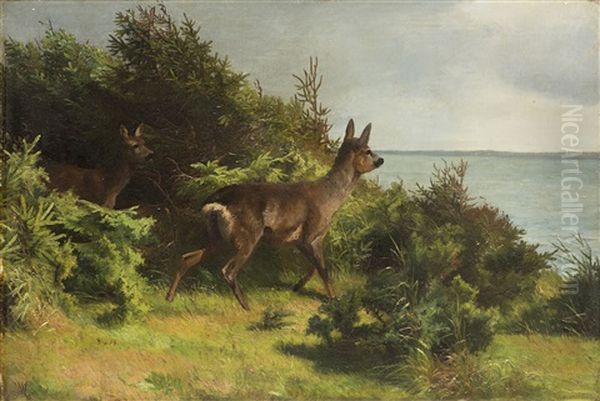
The vast tapestry of art history is woven with threads of varying prominence. While some artists achieve enduring fame, their names echoing through centuries, countless others contribute significantly to the artistic milieu of their time, yet remain relatively obscure to later generations. Adolf Heinrich Mackeprang, a Danish painter active during the latter half of the 19th century, belongs to this latter category. Though detailed records of his life and a comprehensive catalogue of his works are not widely available, existing information allows us to piece together a portrait of an artist working within the rich traditions and evolving landscape of Danish art.
Early Life and Academic Formation
Adolf Heinrich Mackeprang entered the world on February 5, 1833, in Langesø, Denmark. This period placed his formative years just after the zenith of the Danish Golden Age of painting, a time when artists like Christoffer Wilhelm Eckersberg had established a strong foundation based on meticulous observation, classical composition, and a burgeoning sense of national identity expressed through art. The artistic environment Mackeprang grew up in was one steeped in the legacy of this era, yet also beginning to feel the stirrings of new European movements, particularly Realism.
His formal artistic training took place at the prestigious Royal Danish Academy of Fine Arts (Det Kongelige Danske Kunstakademi) in Copenhagen. This institution was the crucible for generations of Danish artists, shaping their technical skills and aesthetic sensibilities. Mackeprang completed his studies there, graduating on June 16, 1863. His time at the Academy would have involved rigorous training in drawing, perspective, anatomy, and composition, likely including copying Old Masters and drawing from life models and plaster casts, standard academic practices of the time.
The Academy in the mid-19th century was a place of transition. While the principles laid down by Eckersberg still held sway, younger artists and instructors were increasingly looking towards contemporary European trends. The influence of French Realism and the Barbizon School's emphasis on landscape painting began to permeate the artistic discourse, challenging the more idealized visions of the earlier Golden Age. Mackeprang's education occurred precisely during this period of stylistic evolution.
Navigating the Danish Art Scene

Emerging from the Academy in 1863, Mackeprang embarked on his career as a painter. The Danish art world he entered was vibrant but also competitive. The legacy of the Golden Age masters like Christen Købke, Constantin Hansen, Wilhelm Marstrand, Johan Thomas Lundbye, and P.C. Skovgaard loomed large. These artists had excelled in portraiture, genre scenes, historical painting, and, particularly relevant for Mackeprang, landscape painting that captured the specific light and atmosphere of Denmark.
Simultaneously, a new generation was making its mark. Artists like Vilhelm Kyhn, who himself became an influential teacher outside the Academy, championed a more direct, naturalistic approach to landscape. Theodor Philipsen, often considered the foremost Danish Impressionist, was beginning his career around this time, deeply influenced by French art and his personal contact with Paul Gauguin. The latter part of Mackeprang's career would overlap with the rise of the Skagen Painters, including Michael Ancher, Anna Ancher, and P.S. Krøyer, who brought a distinct, light-filled realism and plein-air practice to the forefront of Danish art from their base in northern Jutland.
Mackeprang's position within this dynamic scene appears to have been that of a competent practitioner rather than a leading innovator. Information about his participation in major exhibitions, such as the annual Charlottenborg Spring Exhibition (the Academy's official showcase), is scarce. This lack of prominent documentation often characterizes artists who, while skilled, may not have achieved the same level of critical acclaim or public recognition as their more famous contemporaries.
Artistic Style and Known Works
Pinpointing Adolf Heinrich Mackeprang's precise artistic style is challenging due to the limited number of readily accessible works and critical analyses. However, clues can be gleaned from the context of his training and the title of one known painting. His education at the Academy suggests a solid grounding in academic principles of drawing and composition. The period in which he worked saw a general shift from the idealized landscapes of the late Golden Age towards a more naturalistic or realistic depiction of nature.
The one specific work frequently associated with him is titled `Paesaggio con cerbiatti`, which translates from Italian to "Landscape with Fallow Deer". This painting, dated 1863 – the year of his graduation – is described as an oil on canvas measuring 65 x 96 cm. The subject matter firmly places him within the landscape tradition, a genre deeply ingrained in Danish art. The inclusion of animals, specifically deer, was also a common motif in 19th-century landscape painting, often used to add life and narrative interest, or sometimes carrying symbolic weight related to nature and wilderness.
The fact that the title is recorded in Italian might suggest the painting was exhibited or sold in Italy, or perhaps intended for an international market, though this is speculative. Its appearance in auction records, with estimates noted between €1000 and €1500, confirms its existence and circulation in the art market, albeit at a level reflecting his status as a less canonical artist compared to the leading figures of Danish art.
Without viewing `Paesaggio con cerbiatti` or other confirmed works, it's difficult to say definitively whether his style leaned more towards the detailed, somewhat idealized manner of late Golden Age figures like P.C. Skovgaard, or embraced the burgeoning Realism seen in contemporaries like Vilhelm Kyhn. Given the 1863 date, it likely reflects the skills and sensibilities acquired during his academic training, possibly showing a blend of traditional composition with a careful observation of nature. He was, in essence, a product of his time and training, contributing to the broad stream of Danish landscape painting.
The Context of 19th-Century Danish Landscape
To understand Mackeprang's likely artistic milieu, it's essential to appreciate the significance of landscape painting in 19th-century Denmark. Following the national traumas of the early century (including the Napoleonic Wars and the loss of Norway), landscape painting became a crucial vehicle for constructing and reinforcing a sense of Danish national identity. Artists ventured into the countryside, depicting recognizable Danish scenes, from the rolling hills of Zealand to the dramatic coasts of Jutland.
The Golden Age masters established a high benchmark. Eckersberg emphasized precise observation and the effects of light. Købke captured the quiet beauty of everyday surroundings with remarkable sensitivity. Lundbye and Skovgaard became celebrated for their depictions of monumental ancient dolmens and vast beech forests, imbuing the Danish landscape with historical resonance and romantic grandeur. Their work created a powerful visual language associated with the nation.
By the time Mackeprang was active, this tradition continued, but the approach evolved. The influence of Realism encouraged a less idealized, more direct engagement with the landscape. Artists became increasingly interested in capturing specific atmospheric conditions, the changing seasons, and the unadorned reality of rural life. The development of plein-air painting, facilitated by the invention of pre-packaged paint tubes, allowed artists to work outdoors more easily, capturing fleeting effects of light and weather with greater immediacy. While we don't know the extent of Mackeprang's engagement with plein-air techniques, it was a growing trend during his career.
His `Paesaggio con cerbiatti` fits comfortably within this broad genre. Depictions of deer parks, forests, and pastoral scenes were popular subjects, appealing to a clientele interested in representations of nature, whether for its aesthetic beauty, its evocation of tranquility, or its connection to national heritage. Mackeprang contributed to this ongoing artistic conversation about the Danish landscape.
Exhibitions, Recognition, and Later Life
Documenting the exhibition history of artists who were not in the absolute top tier can be difficult. While major figures like Krøyer or Hammershøi have well-documented exhibition records, information for artists like Mackeprang is often fragmentary. Some sources mistakenly attribute exhibition participation in the late 20th and early 21st centuries (Münster 1989, Ahlen 2007, Krumau 2010, Bielefeld 2014) to Adolf Heinrich Mackeprang. This is almost certainly an error, likely confusing him with the much more famous German Expressionist painter August Macke (1887-1914), whose work aligns with the themes and periods of those exhibitions (Expressionism, Modernism).
It is crucial to distinguish Adolf Heinrich Mackeprang, the 19th-century Danish painter, from August Macke. Such confusion highlights the challenges faced by less-famous artists in maintaining a clear historical profile. It is more plausible that Mackeprang exhibited primarily within Denmark, perhaps at the Charlottenborg exhibitions or smaller gallery shows, but comprehensive records are not readily available. His recognition seems to have been modest, reflected in the relatively low auction estimates for his known work compared to major Danish masters.
Adolf Heinrich Mackeprang lived through a period of significant change in Danish art, witnessing the tail end of the Golden Age, the rise of Realism and Naturalism, the flourishing of the Skagen colony, and the beginnings of Symbolism and early Modernism with figures like Vilhelm Hammershøi and J.F. Willumsen. He continued his life and likely his artistic practice into the early 20th century, passing away in 1911. His death occurred just as European art was on the cusp of radical transformations brought by Cubism, Fauvism, and abstraction – movements far removed from the artistic world shaped by his 19th-century academic training.
Distinguishing Namesakes
Further potential for confusion arises from other individuals bearing the Mackeprang name. It is important to note that Adolf Heinrich Mackeprang, the painter (1833-1911), is distinct from Mogens B. Mackeprang, a figure mentioned in historical contexts related to Denmark during World War II and associated with certain student groups. Their lifespans and fields of activity are entirely separate. Maintaining these distinctions is vital for accurate historical understanding. The painter's identity is rooted firmly in the Danish art scene of the 19th century.
Legacy and Conclusion
Adolf Heinrich Mackeprang represents a layer of artistic production essential to the health and breadth of any art historical period. While not a revolutionary figure who dramatically altered the course of Danish art, he was a trained professional who practiced his craft within the established traditions and evolving styles of his time. His focus on landscape painting connected him to a central theme in Danish national art, and his work, exemplified by `Paesaggio con cerbiatti`, contributed to the rich visual culture of the era.
His career spanned a bridge between the enduring influence of the Danish Golden Age and the emergence of later 19th-century movements like Realism and the Skagen School. He worked alongside generations of artists, from the established masters whose legacy he inherited to the rising stars who would define the future of Danish painting, such as Laurits Tuxen or Theodor Philipsen. While overshadowed by these luminaries, Mackeprang's work serves as a reminder of the many artists who populated the studios and academies, participated in the artistic life of Copenhagen, and depicted the landscapes and themes valued by their society.
Though details remain scarce and his name may not be widely recognized today, Adolf Heinrich Mackeprang holds a place, however modest, in the history of Danish art. He was an artist educated at the Royal Danish Academy, active during a period of significant artistic development, and a contributor to the enduring tradition of landscape painting in Denmark. His life and work underscore the fact that art history is not solely the story of famous innovators but also encompasses the steady contributions of skilled practitioners who form the essential fabric of a nation's artistic heritage. Further research or the rediscovery of more of his works might one day illuminate his career more fully. Until then, he remains a representative figure of his time – a Danish painter navigating the artistic currents of the 19th century.